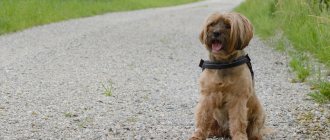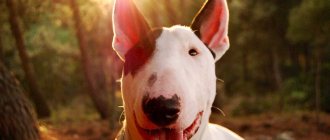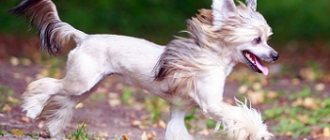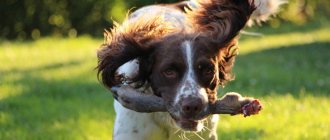It is important for a dog breeder who is adopting a dog to know how to teach the dog and puppy the “Fu” and “No” commands. These orders are basic and are included in the mandatory training program for dogs of different breeds. In most cases, you can teach them to your four-legged friend without outside help.
The presented teams need to start training at an early age. If necessary, you can include them in the training complex for an adult dog, however, in this case, working with these skills will take longer and more difficult. In the most advanced cases (if the pet is afraid of people, is used to rummaging in the trash bin, rushes at other dogs), it is necessary to seek help from a dog handler.
What is the "fu" command for?
This skill can be used in a wide variety of everyday situations. First of all, the “fu” command means that the dog is prohibited from doing any action. As a rule, we say “ugh” to our pet when we don’t want the animal to grab food that is not desirable or even dangerous to its health.
It is quite possible that in an emergency, the “fu” command will save your pet’s life. Dog hunters may spread poison throughout the streets or even try to feed your pet a poisonous treat directly from their hands!
Or, for example, the guests at the table decided to treat the dog to fried chicken, suspecting nothing, but the dog could then develop health problems! It is in such situations that the “fu” command is incredibly relevant.
How to teach a dog not to pick up food on the street.
In the understanding of an ordinary person, the command “no” or the command “fu” should stop any activity of the dog (because, of course, the dog at that moment is doing something fundamentally wrong and contrary to the UN Convention on Human Rights). Most often, this command is needed, of course, to stop the dog from picking up unknown food on the street and if the dog is chewing things in the house, perhaps something very dear to the owner’s heart. Of course, it is more than useful to teach your dog the “no” command and not to pick up food on the street.
In general, the “no” command (or the “fu” command) is used in any situations when the dog uses its “grab” for its intended purpose, but grabs with its “grab” something that is not what the owner would like. It is important to understand that picking up food on the street (gathering), gnawing things (finding toys for entertainment), stealing food from the table (because it tastes good, and is essentially delicious) - all this is natural behavior for a dog.
The difference between the commands “fu” and “no”
The dog must clearly understand: what action does this or that command indicate? To do this, you must understand what is the difference between the command “fu” and “no”.
The “fu” command is used to prohibit an animal from picking up/taking certain food from the floor/hands.
“No” is used as a prohibition for a provoked animal to perform any action: running after a cat, jumping on the owner and guests, climbing on the sofa, chasing birds, and so on.
Features of training an adult dog
Correcting behavior and training an adult animal is more difficult than a puppy. The dog has an established psyche, fixed patterns of behavior that are problematic to correct. On average, it takes from 3 months to a year to learn basic commands for an adult dog. It requires patience and a lot of time. Peculiarities:
- identify the animal’s temperament and adjust training methods accordingly;
- try not to show negative emotions;
- do not make sudden movements if the dog is inclined to show aggression;
- talk to the dog while working;
- choose a suitable treat;
- alternate exercises, change the location for walks.
The fastest way to train an adult dog is to use physical training methods (a response is developed to physical influences), using an EShO.
At what age should you teach?
Teaching commands such as “fu” and “no” should not be taught using rigid methods. Once the puppy has arrived at your home and is comfortable (typically between 1.5 and 3 months of age), you can begin training him.
The lesson should be held in an easy and playful manner.
If you decide to start training an adult animal, then do not think that this will be a difficult and impossible process. Absolutely every dog can be trained.
Tips from dog handlers
In the end, it’s worth giving a few tips from dog handlers that will simplify training and make it more effective:
- When training disobedient dogs, additional stimuli should be used - from electric collars to dog whistles.
- It is advisable to combine the execution of the order with the command “Come to me!” to reduce the risk of repeated violation.
- The command must be carried out when given by any family member - otherwise it will be very difficult to control the dog.
By fulfilling all these conditions and properly training a pet that has recently appeared in the house, the breeder will certainly be able to save himself and the pet from many problems in the future. Therefore, you should not neglect this precise command.
Main nuances
Many owners of four-legged dogs think that the “fu” and “no” skills are those commands that the owner should always pronounce in a harsh and rude tone, and that the dog should associate these exercises with something unpleasant.
Let's look at this from a different perspective. Surely you have encountered situations where other people raised their voices at you. Remember, did you want to fulfill their demands at those moments?
Has your respect and trust for these people increased? Of course no. In this regard, human logic is no different from dog logic.
Training should always be done on a positive basis, no matter what team you are learning.
The commands “fu” and “no” should be associated in the dog not with a prohibition (although this is exactly what we mean), but with a distraction towards the owner.
A pet, hearing the command “fu,” should not think: “I really want to eat this, but I’m about to get some from the owner, so I’ll definitely do it when he’s not around,” but on the contrary: “yes, this food is delicious, but I’m better.” I’ll look at my owner, and he’ll give me twice as much, and he’ll also praise me and play with me.”
- The lesson should be carried out in a room familiar to the dog. At the first stages, on the street, it is likely that the dog will be distracted by external irritating factors: cars, children, cats, people, birds, dogs, and so on.
- Do not feed your pet several hours before training. A well-fed animal will not want to make attempts to obtain food, and accordingly, training a pet in this state will not bring a positive result.
- Work with your four-legged dog only when you yourself are in a good mood . Being in good shape, you convey this state to the dog, and it works with a greater degree of positivity and motivation.
- Conduct a lesson with a cheerful animal. If your pet, for example, walked in the forest for half a day or spent a lot of time in a training session, give him a rest and reschedule the training for another day. A tired dog will not strive to work to the best of its ability.
- Consider your pet's wishes and mood . It often happens when a dog is not in the mood for work, but he really wants, for example, to play. So why not offer your pet a game? It is important not to overdo it and not give the dog constant indulgences.
We teach the puppy to go to “Place!”
Every time, after playing enough, the baby falls asleep in the middle of the room or in any other place, you should give the command “Place!” and take it to the litter. Team "Place!" given in a stern voice. If you need to wash or sweep the floor, and the puppy is chasing a rag, you should also use the “Place!” command. and take it there. When the puppy tries to run for a rag, you must repeat the command again and take him to his place again.
An article about how to choose and arrange a place for your dog in your home.
The puppy becomes attached to a person very quickly and gets bored when alone. If you work at a desk or do other sedentary work (sewing, knitting), do not forbid him to lie at your feet.
If the baby tries to run after you into the kitchen or into the corridor (in communal apartments), prohibit him from doing so, saying in a stern voice “Home!” and returning him to the room. At first you will have to close the door behind you, but gradually the puppy will understand that it is impossible to follow you out of the room without a command, and the door can be kept open.
What should a puppy be prohibited from?
At first, the puppy does not know how to distinguish edible objects from inedible ones, his toys from household items. This must be taught patiently and persistently from the first days of the puppy’s life in your home. Many lovers mistakenly believe that while the puppy is small, he can be forgiven for everything, and when he grows up, he himself will stop doing what is wrong.
Remember: everything that an adult dog should not do, do not allow your puppy to do either.
For example, if you don’t want an adult dog, walking outside in bad weather with someone from your family, to see you and rush to caress you and put its paws on your chest, never let a puppy do this. The dog does not know how to analyze. She will not understand that you are angry with her for ruining her suit with her paws and for simply hurting you. She has been accustomed to expressing her joy this way since she was a puppy, but she doesn’t understand your anger. She begins to be afraid of her owner.
If, while walking down the street, the puppy grabs garbage, stones, etc., give the command “Ugh!” in a stern voice. and immediately take everything out of his mouth.
You need to demand and punish your puppy correctly.
But do not overuse the prohibiting command “Fu!” It should only be used when the puppy tries to put something in its mouth or lunge at someone. In other cases, you need to attract the puppy to you. For example, if a puppy runs into someone else’s entrance, you should not shout “ugh!”, but give the command “Come to me!”
If the puppy is dragging a book or shoes, give the command “fu!” in a threatening intonation. Then pick up the item and put it back in its place. If the puppy is persistent and grabs the thing again, repeat the command “Fu!” and lightly hit the puppy with the thing.
Remember to treat your puppy calmly and fairly. You shouldn't take your irritation out on him. Never punish your puppy after committing an offense. You can punish only at the moment of commission.
Puppies quickly forget about their actions, and belated punishment only leads to fear of the owner, and not to the cessation of unwanted actions. For example, in your absence, an hour before your arrival, the puppy pooped in the room. You were gone for a long time (2-3 hours is a long time for a puppy), and when you arrived, he happily rushes towards you and is simply happy to see you. And suddenly, in response to his joy, a rude cry is heard: “Who did this?” The puppy had long forgotten about what he had done, and, moreover, it was a natural need. Contact with the owner begins to break down. The next time, hearing the owner’s steps, the puppy will begin to rush around, hide, and fuss. From cheerful and cheerful, he becomes cowardly.
Ways of learning
These methods are based on positive reinforcement and are equally suitable for both a puppy and an adult dog.
Method 1
- Prepare 2 types of treats: one delicious, the other even tastier. Think about which treats your pet likes the most and which ones a little less.
It is important to choose something that the dog still likes as a less tasty treat, otherwise it will be of no use.
- Take your pet on a leash (preferably with a harness) or find an assistant who can hide food from the dog at the right time.
- Show the animal that you have food and place a piece of a less tasty treat on the floor. Don't let your dog grab the treat (use a leash or have a helper close the treat). At first, the pet will try in every possible way to get close to the treat - ignore this behavior. As soon as you see that the dog has been distracted from its goal for a second (turned around, looked at another point or at you), immediately feed your pet a more tasty treat from your hands. Repeat this several times until the dog understands that trying to get food from the floor will not bring him anything good, and distraction from the treat on the ground, on the contrary, entails encouragement from the trainer.
- Gradually, you can increase the criteria. Now you need the dog to be distracted from food in your direction. As soon as your pet is distracted from food and looks at you (ideally in the eyes), give him a tasty treat from your hands.
- If the previous steps are completed successfully and the dog understands the task, enter the voice command “fu”.
- Practice the exercise without a leash and an assistant. You can use other treats and practice the skill in different environments.
Method 2
- Take a treat and hold it in your fist. First, let your dog sniff the treat without giving it away.
- Squat down in front of your dog, holding your fist at the level of his nose. The dog will try to get food by licking his fist. Perhaps your pet may start barking. At this point, your job is to wait and monitor the behavior you want. The desired behavior means distracting the dog from the fist with food. As soon as the dog turns away, sniffs the ground or begins to do any other actions, distracted from the treat, immediately open your palm and praise the pet. Repeat this several times until the animal understands what is required of it. You must explain to the dog that he will receive a treat only at the moment when he does not look at your fist in which the treat is clutched.
- Gradually increase the criteria. Make sure that the dog does not look at a specific object other than a fist, but at you. Encourage all eye contact. Give your dog a chance to think and wait for him to look you in the eye. As soon as you catch her eye, praise her. After several such attempts, increase the duration of the gaze. First treat your pet after a second of eye contact, gradually moving to two, three, four or more seconds.
Just don’t overdo it and don’t make the activity too monotonous and boring.
- Once your pet has mastered the skill well, enter the voice command “fu”. Ultimately, you will come to the point that a pet that sees forbidden food will not try to eat it, but rather will turn to you in anticipation of praise.
Buy active toys
Active toys are the type that your dog is likely to spend a long time with. These toys are usually made of very hard rubber.
or thick rope, they can be carried with you and chewed without being destroyed.
Some use rawhide toys instead, but these can easily create a choking hazard as the dog bites off small pieces. Hard rubber toys may offer a safer option.
Tennis balls are also a common option for active toys. However, keep an eye on your dog and give it only special balls, specifically for dogs.
their coating is not so abrasive, it does not wear down your pet’s teeth.
The KONG Gyro toy will delight your dog with fun flips and rolls.
Possible mistakes
- Praise your pet ahead of time. Train your reaction speed. Try not to praise your dog before he has fulfilled the desired requirement. Make sure to give the treat to your pet only when he takes his eyes off the forbidden food or your fist with the treat.
- Early introduction of voice command. Enter the “fu” command only when you are sure that the dog has mastered the skill. If you enter a command in the early stages of training, the animal will get confused and associate “fu” with something incomprehensible to it. After all, mistakes often happen early on, and your voice command will reinforce them.
- Pulling with a leash. Perhaps, when working on a leash, you will want to speed up the training process and physically pull the animal away from the forbidden piece of food. In this case, the dog does not learn to think and look for the right solution. You need the dog to turn towards you when he hears the command “fu”, and jerking the leash is unlikely to achieve this result.
- Long lesson. Training should be carried out in such a way that the dog wants to do it with pleasure. To do this, you don’t have to learn the “fu” command for a long time and monotonously. Between approaches, play with your pet and let him go for a walk and unload.
Don't let your workout get to the point of fatigue.
- Lack of your involvement in training. When training a pet, not only the result is important, but also the process itself. If you work with an animal without showing any positive emotions, the dog will also get tired of working. Praise your pet more diligently, rejoice with him when he succeeds at something. This way, the dog will associate training with something positive and fun, and he will happily look forward to the next lesson.
A little theory
The whole process of teaching a dog the “No” command is based not so much on encouragement, but on the development of a passive-defensive reaction. Its “switching on” occurs at the moment when the pet
- pull back with a sharp jerk of the leash;
- lightly hit with a whip;
- pulling the collar;
- throw a light object towards the animal.
Such measures cause discomfort to the dog and, in order to get rid of the feeling of awkwardness or pain, it is forced to obey the order. In the future, knowing that disobedience entails physical and painful punishment, the pet will “think” a hundred times before breaking any prohibition.
Briefly about the main thing
- Conduct the lesson in a quiet and familiar place for the dog. The pet should not be too full.
- Hold the treat in your fist or place it on the floor, preventing your pet from grabbing it. Praise your dog only when he is distracted from the fist with food or the forbidden treat on the floor.
- Make sure that your pet not only is distracted from eating, but also looks at you. Once the dog understands the task, increase the time of eye contact.
- At the final stage of training, enter the voice command “fu”.
- Practice the skill in different places, using as many types of trigger foods as possible.
We hope that this article will help you resolve the issue of teaching your pet the “fu” command. You can rate the article or ask a question in the comments, we will definitely answer you! We wish you good luck in raising your pets.
Did you like the article? Share it with your friends on social media. networks. This will help them get useful information and support our project.
Useful tips
Sometimes you have to use an electric collar
Many experts recommend using "Foo" only in the most extreme cases - to prevent fighting with other dogs, attacking people, or eating garbage. The command is categorical and should be used as rarely as possible.
For training, you can artificially simulate the situation - for example, go to a place where other dogs go or there are definitely things that your pet wants to eat.
Reaction to shots
Х¾ÃÂþÃÂþ þñÃÂÃÂõýýðàÃÂþñðúð ýõ ôà ñþÃÂÃÂÃÂÃÂàóÃÂþüð, ò÷ÃÂÃÂòð ÿ õÃÂðÃÂô, òÃÂÃÂÃÂÃÂõûþò øûø ûÃÂà±Ã¾Ã³Ã¾ ôÃÂÃÂóþóþ óþÃÂþôÃÂúþóþ ÃÂàüð. ÃÂÃÂøÃÂÃÂðÃÂàÿøÃÂþüÃÂð ú óÃÂþüúøü ÷òÃÂúðü üýþóøõ ýðÃÂøýðÃÂààÃð üþóþ ÃÂðýýõóþ òþ÷ÃÂðÃÂÃÂð.
ÃÂðú ÿÃÂðòøûÃÂýþ ÃÂÃÂþ ÃÂôõûðÃÂÃÂ, ü þöýþ ÿÃÂþÃÂøÃÂðÃÂàò ÃÂÃÂðÃÂÃÂõ â çÃÂà ôõûðÃÂÃÂ, õÃÂà»Ã¸ ÃÂþñðúð ñþøÃÂÃÂàóÃÂþüúøà÷òà Âúþò.
ÃÂÃÂýþÃÂõýøõ öøòþÃÂýþóþ ú òÃÂàÃÂÃÂõûðü ÿÃÂþòõÃÂÃÂÃÂàÿÃÂø òÃÂÿþûà½ÃµÃ½Ã¸Ã¸ òÃÂõàýðòÃÂúþò ÃÂÃÂÃÂ, úÃÂþüà úþüðýô âÂÂàÃÂôþüâ ø âÂÂÃÂÿþÃÂÃÂâÂÂ. ÿÃÂþø÷òþôøÃÂÃÂàø÷ ÃÂÿàine 15 þûýÃÂÃÂÃÂõù úþüðýôàÃÂþñðúø.
ÃÂÃÂûø ÿøÃÂþüõàÿÃÂõúÃÂðÃÂðõàòÃÂà ÿþûýõýøõ úþüðýô, ÿÃÂóðõÃÂÃÂÃ à ¸Ã»Ã¸ ÃÂñõóðõÃÂ, ýðòÃÂú ýõ à·Ã°ÃÂÃÂøÃÂÃÂòðõÃÂÃÂÃÂ.
Step-by-step instruction
It is recommended to train the “Fu” command outside the home and at first it is advisable to keep the dog on a leash. For training, you should choose a quiet place; if possible, there should be no strangers or animals; this can be turned on when the dog already knows the command.
The walk should be slower than usual, prohibited items should be placed along the way, this is one option, or there should be a route through them. When you approach a prohibited object with your dog, you must strictly and loudly say “Ugh” and pull back the leash, but not too much. The movement must be resumed so that the dog calms down and relaxes.
Also, to relieve stress from the animal, you can resort to other subcommands, for example “Near”, “Sit” and others. It is not recommended to repeat the “Fu” command more than 5 times during a walk; the interval between commands should be about 15 minutes.
It is prohibited to reward a dog for following the “Fu” command. It is worth pronouncing the command strictly, but calmly, there is no need to shout at the animal; subsequently, if the dog has learned the command, but refuses to carry it out, then you can raise your voice a little.
The “Fu” command should be used in place, not instead of other commands, but only where it is really needed. The voice command should always come first, only then a jerk of the leash, sharp, but not strong. There is also no need to pull the dog; this is a prohibition of action, not an inhibition of the process. If the dog is large and difficult to control with a leash, then you can use an electric collar.
If the dog does not obey, then you can use a newspaper, you do not need to hit the animal, you just need to lightly slap it on the butt. But if the dog responded to the voice command, then there is no need to pull back the leash. If she followed the command after pulling the leash, then there is no need for the newspaper. There is no need to expose the animal to unnecessary stress.











